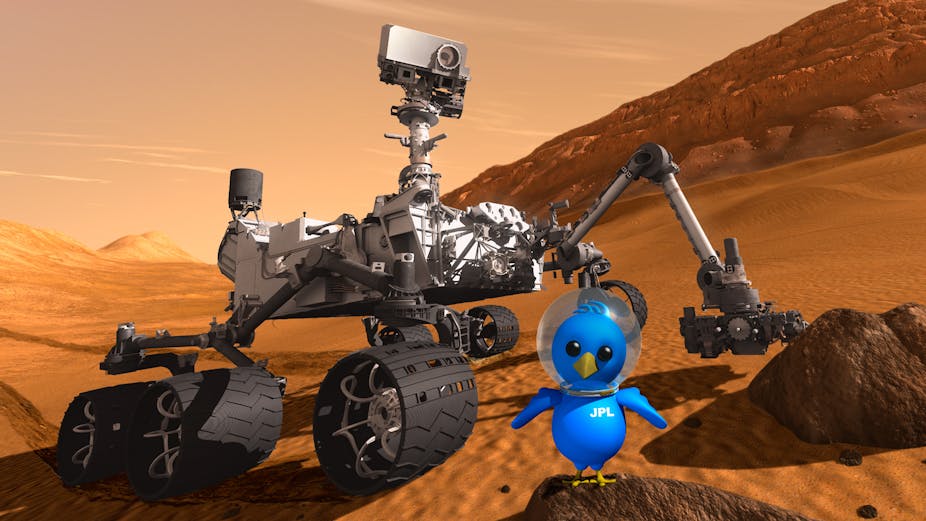Social media is the new frontier for space exploration, shaping an age of innovative public participation in space missions.
While online communities are a-Twitter about NBC’s poor Olympic coverage, there’s also excitement for a broadcast of a different nature. This week we learned that NASA’s latest and greatest Mars rover, Curiosity, had secured arguably the greatest piece of media real estate to broadcast its landing: a big screen in New York’s Times Square.

Curiosity is set to land on the red planet on Monday afternoon, 3:31pm AEST, amid a flurry of tweets, posts and live-streaming action. Curiosity, officially named the Mars Science Laboratory, is set to solve the planetary puzzle of whether life once existed, or still does exist on Mars.
Before the Mars rover program was officially on our radars, baby boomers experienced Man’s first lunar steps by huddling around a black-and-white TV or wireless. As the technological and social landscapes have evolved, so has our experience of major events. How will we access and share information about the red planet in 2012 and beyond?
People are directly connecting and engaging with space missions through social media. For every NASA mission, there are Twitter accounts, Facebook pages and Google+ profiles to match.
Sure, profiles in the persona of a spacecraft are fun to follow, but do they have a greater impact on people than just appearing in their Twitter feed? If people connect with a spacecraft’s “personality” will they be more likely to engage with the science behind the mission?
Before the days of the interwebs, in 1977, the Voyager spacecraft launched with only a few hundred people watching. Some 35 years later, Voyager 1 and 2 can’t hide from online attention despite being at the very edges of our solar system. An animation (see above) showing Voyager travelling through space, bored, lonely and wishing it was closer to its home planet (until it runs into Dr Who, that is) was quick to rise to YouTube popularity.
In addition to being a cute animation, twin spacecraft Voyager 2 is on Twitter, updating us about its mission progress and answering our curly questions.
By personifying spacecraft in the form of social media accounts we’re characterising spacecraft in an easily accessible way which allows people to connect with specific missions. Imagine the buzz around the Voyager launch back in 1977 if those few hundred people were able to share their excitement like they can today.

In 2009 NASA began running “tweetups”, events during a mission launch designed for Twitter users to meet up in person and live tweet their experience to the world. Now rebranded as “NASA socials” to include Facebook users, more than 2,000 people have attended these events and broadcasted their experiences over the past few years.
For the Mars Curiosity launch tweetup last year, Will.i.am. (of Black Eyed Peas fame) came along to DJ the launch. Rarely do scientific endeavours attract celebrity endorsement or involvement.
For the large percentage of people that won’t get to see a rocket launch in person, there’s always the online space to experience the giant leaps for (tin)man kind. When the svelte humanoid robot Robonaut was turned on inside the International Space Station last year, he shared his first moment with the Twitterverse:

While this attracted a whole lot of robot love, tweeting from space is nothing new. In 2010 space station commander and astronaut Doug Wheelock checked in from space with foursquare (let’s be honest, foursquare was pretty 2010). He was awarded a “NASA Explorer” badge for his feat, much to the envy of many hardcore foursquare badge collectors.

Surely it can’t be long until the first check-in on Mars or until a Ustream broadcast of a rover experiment goes live (albeit with the 14 minute time delay necessary for the images to get back to Earth).
Curiosity is not shy of public attention and might just be the robot to check in from another planet. Curiosity Cam, the rover’s dedicated Ustream channel, has had almost 4.5 million views since the camera went live in the Jet Propulsion Lab cleanroom during the rover’s construction in 2010.
The number of viewers for Monday’s landing broadcast is sure to rival attention directed at the final Space Shuttle mission, STS-135. Here in Australia, we’re doing our bit to ease Curiosity through its “seven minutes of terror” (see video above) including atmospheric entry, descent and landing on the red planet.
While 900 kilograms of robot awesomeness speeds into the Martian atmosphere, the antennas at NASA’s Deep Space Network tracking station outside of Canberra will be listening. Officially called the Canberra Deep Space Communications Complex, these NASA-owned and CSIRO-operated dishes will have the only direct view of the landing. We are also bringing you our first Ustream broadcast, from the Martian festivities at the Landing Party.
So as the elaborate sky-crane lowers the Curiosity rover on to the Martian surface, what will you be doing? If you are too young to remember the Apollo 11 landing, charge your iDevices – this could be your Apollo moment.

